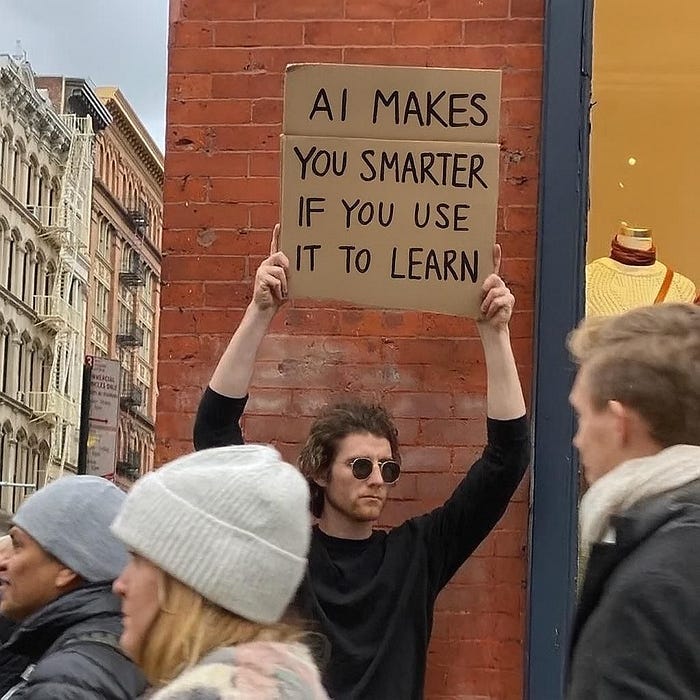The problem isn't that the answers are bad. Most people don't know how to prompt for deep learning. The right prompts turn AI from a trivia machine into a personal tutor, strategist, and thinking partner.
Below are five prompts designed to help you learn faster, remember more, and apply ideas in real life. Think of them as training wheels for building an AI-assisted learning habit.
1. Harvard-level paper breakdown
Prompt:
"Read this academic article or textbook chapter on [paste excerpt or topic]. Break it down into 5 key insights. For each, give a real-world example or analogy and one question I should reflect on."
Why it works: Dense, academic material can be a slog. This prompt forces AI to:
- Extract the main ideas.
- Attach them to tangible, real-world examples.
- Give you a reflection question to deepen understanding.
It's the difference between memorizing definitions and being able to explain a concept at a party.
Example in action: You paste it into a section on neural networks. AI boils it down into:
- How layers process inputs (with a kitchen assembly line analogy).
- The role of weights and biases (compared to seasoning a recipe).
- Overfitting is a problem (likened to over-rehearsing lines in a play). …and so on, with a reflection question like: "Where in your work have you seen overfitting-type mistakes?"
2. Socratic dialogue simulation
Prompt:
"You are a Socratic tutor. Ask me deep, thought-provoking questions one by one on [topic], increasing complexity as I respond. Don't reveal answers unless I ask."
Why it works: This isn't a lecture. It's active, mental sparring. AI pushes you to reason through the topic, layer by layer, much like the Socratic method in philosophy or law school.
The key benefit? You uncover gaps in your knowledge without the embarrassment of doing it in front of a real audience.
Example in action: You're studying blockchain. AI starts with:
- "What is a blockchain in your own words?" Then moves to:
- "How would removing the consensus mechanism change its function?" Finally:
- "Design a blockchain-based voting system — what vulnerabilities would you need to address?"
3. Cheat sheet generation
Prompt:
"I need a cheat sheet for [specific topic like cosine similarity, LTV modeling, Porter's 5 Forces]. Include formulas, worked-out examples, common mistakes, and mnemonics if possible."
Why it works: Sometimes, you don't need a course; you need a crystal-clear one-pager. This prompt produces a tight, ready-to-use reference that is perfect for quick study or workplace application.
Example in action: For cosine similarity, you get:
- The formula.
- A worked-out example using customer preference vectors.
- A list of common pitfalls (like forgetting to normalize vectors).
- A mnemonic like "Cats Prefer Treats" for Cosine = Projection / Total.
4. Case study reframing
Prompt:
"Here's a case: [paste summary]. Re-analyze it using these 3 mental models: [name them]. Explain what each model reveals that others might miss."
Why it works: Real-world decisions rarely have one clear answer. By examining a scenario through multiple lenses, such as first principles, SWOT analysis, and inversion, you force yourself to think multidimensionally.
Example in action: You paste a case about a failing retail chain. AI:
- Uses first principles to strip the problem down to core assumptions.
- Applies SWOT to highlight untapped strengths in customer loyalty.
- Runs an inversion to explore how a competitor might deliberately sink the brand.
This isn't just academic — it's strategic cross-training.
5. Job interview prep
Prompt:
"Here are my raw notes: [paste bullets]. Turn them into a short story with a clear setup, conflict, turning point, and resolution, suitable for an interview or presentation."
Why it works: Interview success often comes down to storytelling. Data points are forgettable, but a compelling narrative sticks. This prompt forces AI to wrap your achievements in a memorable and persuasive structure.
Example in action: Your bullet points say: "Missed Q1 goals, reorganized team, hit 130% in Q2." AI transforms it into:
- Setup: A quarter in the red.
- Conflict: Morale low, sales slipping.
- Turning point: Restructured outreach strategy, paired new reps with veterans.
- Resolution: Surpassed targets by 30% next quarter.
The bigger picture
Prompts like these aren't just shortcuts. They're frameworks for thinking. You're training AI to think with you, not just for you — and that's where the learning magic happens.
Start with one, see how it changes your understanding of a topic, and then stack them into your personal "AI learning playlist."
Because in the age of intelligent tools, knowing how to learn with AI is just as valuable as knowing about AI.
Think Like an AI Strategist in 1 Week. Register now! https://community.genai.works/plans/1538168?utm_content=332868887&utm_medium=social&utm_source=linkedin&hss_channel=lcp-95731503
Stay ahead with AI news in real time. Follow us on X for expert takes, live updates, and top trends as they happen. https://x.com/GenAI_Now
Want deeper takes and specialized AI insights? Subscribe for daily updates or choose your favorite topics — healthcare and finance. https://newsletter.genai.works/subscribe
Built an AI tool? Get it featured in our community of 12M+ https://6hhfxazcbpc.typeform.com/to/O392AQRW?typeform-source=lnkd.in
AI can be smart and hilarious. Follow us for funny moments, daily surprises, and real talk about tech.
Instagram: https://www.instagram.com/generativeai_official?igsh=Zjc3NGU5N2ticzZ6 Quick Facts: 6+M Followers | 3M+ Newsletter Subscribers. Largest and fastest-growing AI community on LinkedIn, founded and backed by AI experts in the industry.

